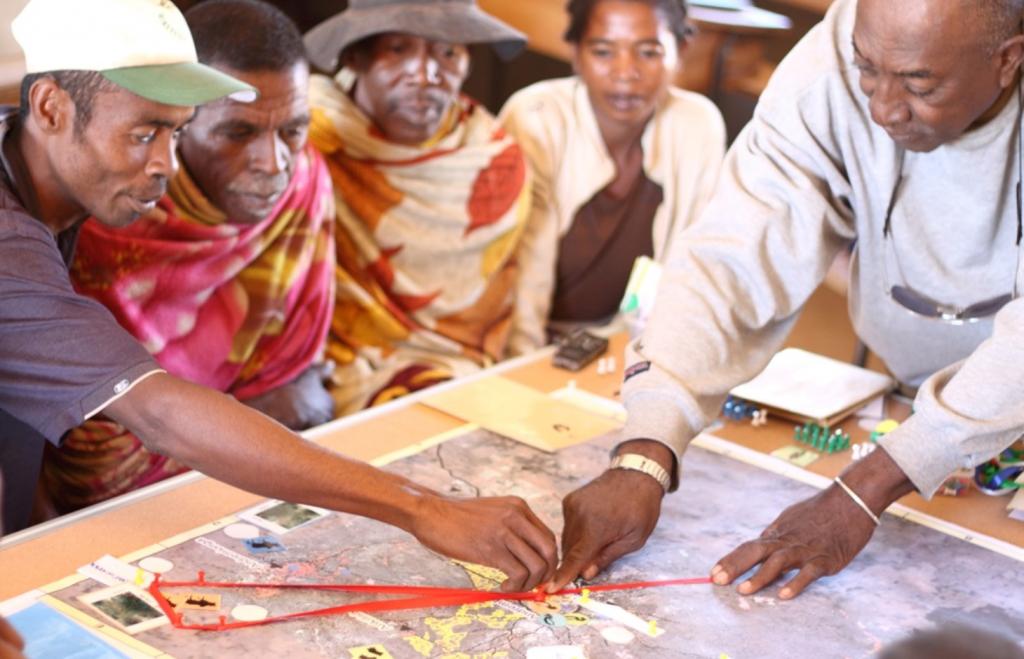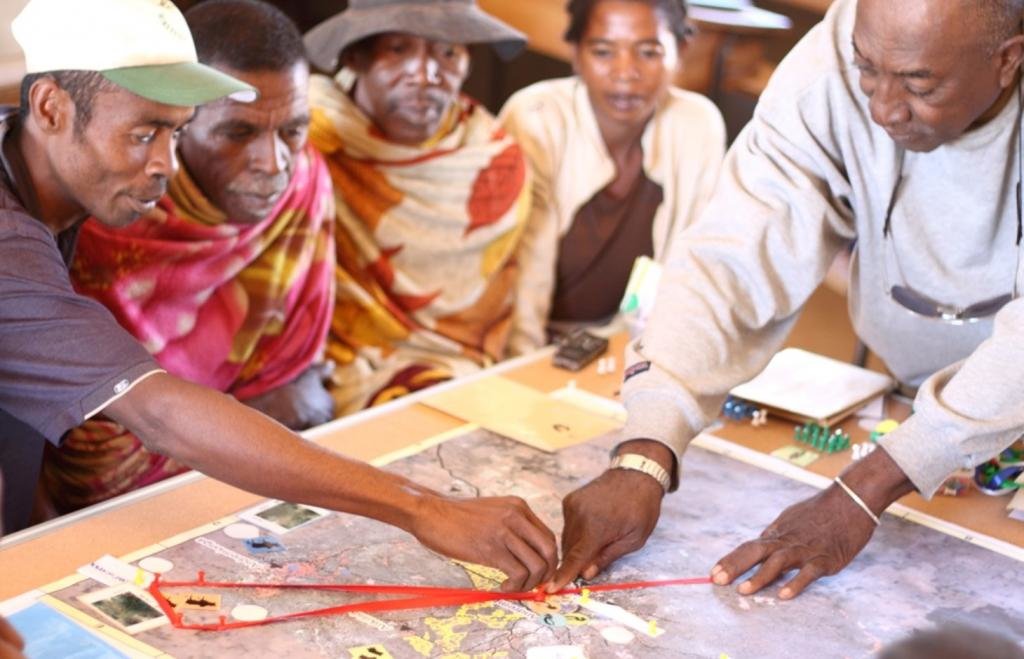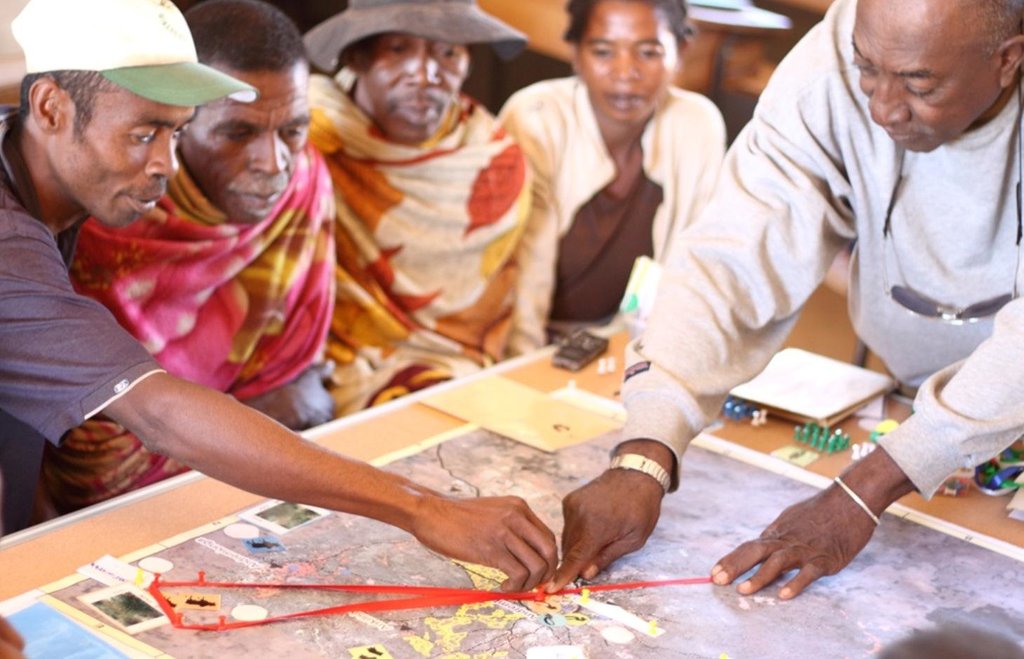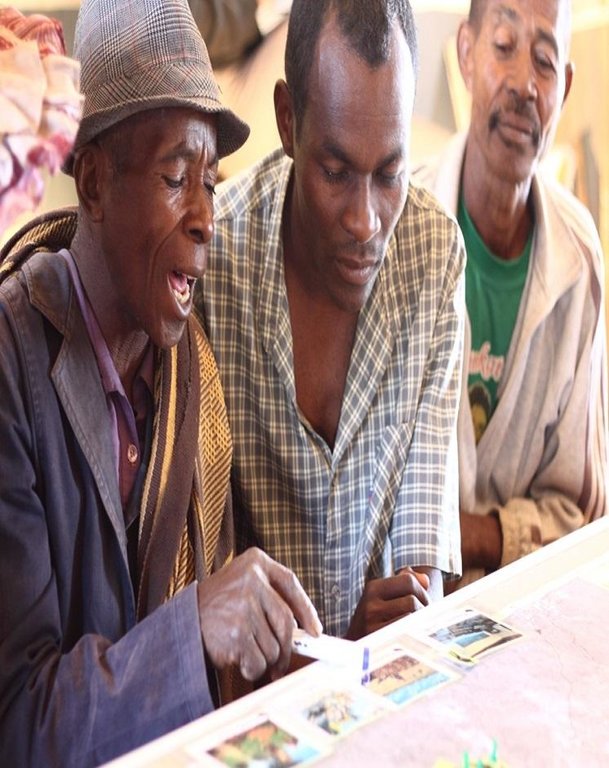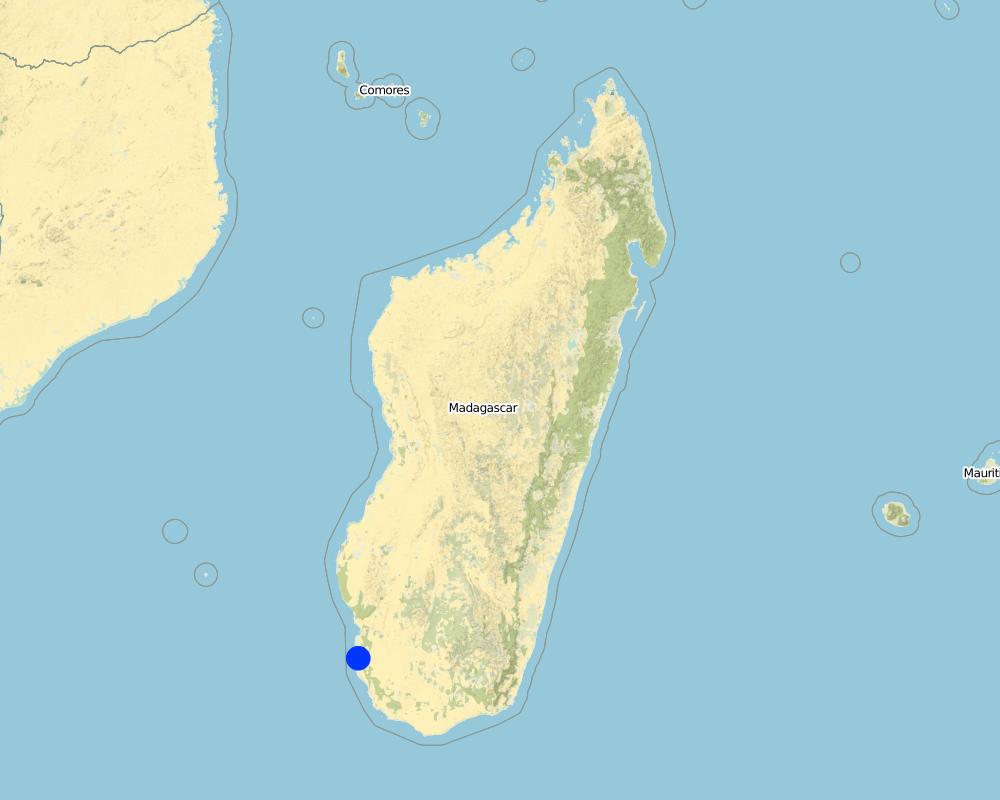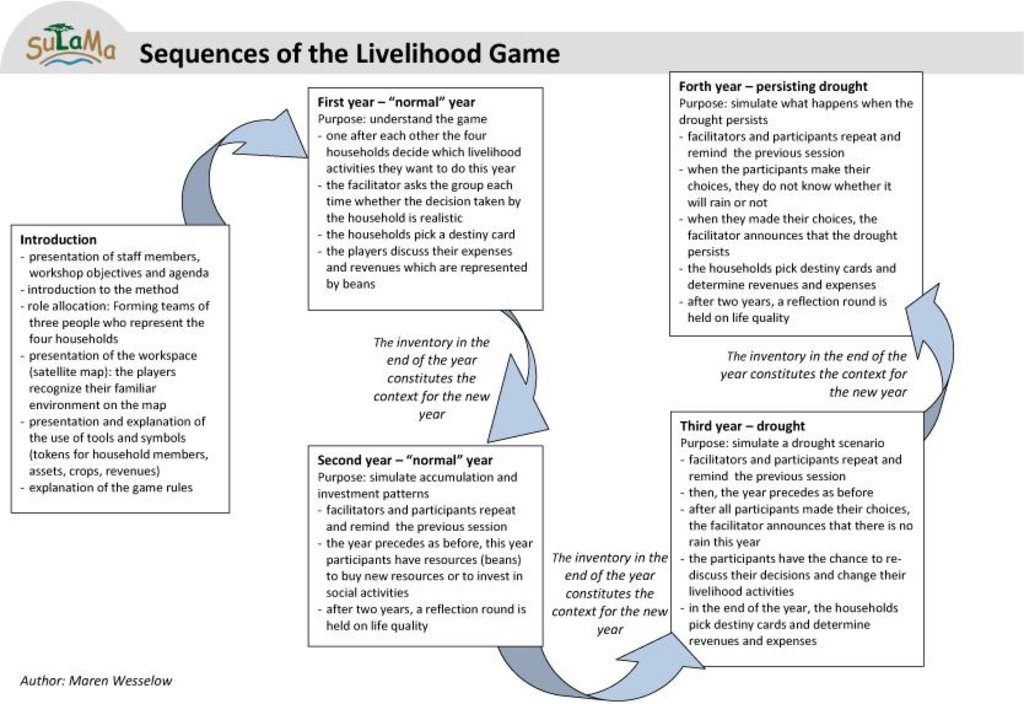Role-Playing Games in Natural Resource Management [มาดากัสการ์]
- ผู้สร้างสรรค์:
- การอัพเดท:
- ผู้รวบรวม: Maren Wesselow
- ผู้เรียบเรียง: –
- ผู้ตรวจสอบ: Fabian Ottiger
approaches_2600 - มาดากัสการ์
ดูส่วนย่อย
ขยายทั้งหมด ย่อทั้งหมด1. ข้อมูลทั่วไป
1.2 รายละเอียดที่ติดต่อได้ของผู้รวบรวมและองค์กรที่เกี่ยวข้องในการประเมินและการจัดเตรียมทำเอกสารของแนวทาง
ผู้เชี่ยวชาญ SLM:
Razafindramonja Mahaleo Claude
mahaleo.claude@gmail.com
Université de Tuléar
มาดากัสการ์
ผู้เชี่ยวชาญ SLM:
Babarezoto Fenohaja
babarezotofenohaja@gmail.com
Université de Tuléar
มาดากัสการ์
ผู้เชี่ยวชาญ SLM:
Rakotondranary Jacques
jacques.rak@gmail.com
Université de Antananarivo
มาดากัสการ์
ชื่อของโครงการซึ่งอำนวยความสะดวกในการทำเอกสารหรือการประเมินแนวทาง (ถ้าเกี่ยวข้อง)
Sustainable Landmanagement in south-western Madagascar (SuLaMa / GLUES)ชื่อของโครงการซึ่งอำนวยความสะดวกในการทำเอกสารหรือการประเมินแนวทาง (ถ้าเกี่ยวข้อง)
University of Greifswald (University of Greifswald) - เยอรมนีชื่อของโครงการซึ่งอำนวยความสะดวกในการทำเอกสารหรือการประเมินแนวทาง (ถ้าเกี่ยวข้อง)
University of Antananarivo - มาดากัสการ์ชื่อของโครงการซึ่งอำนวยความสะดวกในการทำเอกสารหรือการประเมินแนวทาง (ถ้าเกี่ยวข้อง)
Université de Tuléar - มาดากัสการ์1.3 เงื่อนไขที่เกี่ยวข้องกับการใช้ข้อมูลที่ได้บันทึกไว้ผ่านทาง WOCAT
วันที่เก็บรวบรวมข้อมูล (ภาคสนาม):
01/08/2014
ผู้รวบรวมและวิทยากรหลักยอมรับเงื่อนไขเกี่ยวกับการใช้ข้อมูลที่ถูกบันทึกผ่านทาง WOCAT:
ใช่
2. คำอธิบายของแนวทาง SLM
2.1 การอธิบายแบบสั้น ๆ ของแนวทาง
Participatory simulation to foster stakeholder dialogue in natural resource management, conciliate resource conflicts and enable participatory land use planning
2.2 การอธิบายอย่างละเอียดของแนวทาง
การอธิบายอย่างละเอียดของแนวทาง:
Aims / objectives: Two role-playing games were designed to understand land users' livelihoods strategies in both “normal” but also in times of drought events and cattle raids. The aim was to find out how, and why, livelihood decisions differed between household types in south-western Madagascar. Under the role-playing methodology, land users actively participate through discussing livelihood strategies, negotiating interests, and planning for the future. The methodology proved to be very dynamic, interactive and useful.
Methods: The SuLaMa project is a five-year Malagasy and German research project involving an interdisciplinary team (consortium) that aimed at developing sustainable land use techniques in south-western Madagascar. To validate soft-models that fed into computer-based models on land use change in the region, four workshops were held in four villages on the Mahafaly Plateau. Two groups of land users, with twelve participants each, worked simultaneously in each village: a total number of 96 participated. The games, ‘Livelihood Game’ and ‘Livestock Game', were designed to foster both scientific knowledge production on land use systems, and dialogue with land users. The essence of the methodology is that participants assume the roles of different household types and simulate their annual livelihood activities on a village map. The four household types differed from relatively wealthy (owning cattle; a lot of land) to poor (no cattle, little land). Each household type was represented by two or three participants and roles were allocated randomly.
Stages of implementation: The 'Livelihood Game' covers a time span of four fictive years. Each round represents the household’s annual subsistence decisions. In contrast, the 'Livestock Game' covers just one year with each round encompassing one of three seasons. In the 'Livelihood Game', players have a set of activity options: for example they can locate fields on the map and choose how to cultivate them. Moreover, additional activities like livestock keeping, charcoal making, paid work, collecting/hunting or educating children are available to them. The 'Livestock Game' concentrates on grazing and animal feeding decisions. Each decision is visualized by pictured cards, tokens and symbols - and grazing areas are mapped. While this participatory simulation remains a game, it would be feasible to integrate the methodology into a land use planning process.
Role of stakeholders: Initially, the joint interdisciplinary team conducted a baseline survey using Rapid Rural Appraisal tools to gain a general understanding of local socio-ecologic systems. Following this, a quantitative household survey was carried out in several villages (665 households in total) to analyse household composition and structures. Based on the results, researchers designed the structure of the role-playing games.
Other important information: A crucial precondition was that local communities were well-informed and participation was voluntary. This was achieved by an ‘announcement tour’ where timings were adapted to social, cultural and labour schedules of the local population. The communities were invited to determine the participants according to specific criteria. Participants had to be those who practiced the typical livelihood activities of agriculture and livestock keeping, and who contributed to household decision-making. Furthermore, a balance in terms of gender, age and lineage was requested.
2.3 รูปภาพของแนวทาง
2.5 ประเทศ ภูมิภาค หรือสถานที่ตั้งที่ได้นำแนวทางไปใช้
ประเทศ:
มาดากัสการ์
ภูมิภาค/รัฐ/จังหวัด: :
Mahafaly Plateau, South-Western Madagascar
ข้อมูลเฉพาะเพิ่มเติมของสถานที่ตั้ง:
Betioky-Atsimo
Map
×2.6 วันที่เริ่มต้นและสิ้นสุดของแนวทาง
ระบุปีที่เริ่ม:
2014
การสิ้นสุดลง (ถ้าแนวทางไม่ได้ใช้อีกต่อไป):
2015
2.7 ประเภทของแนวทาง
- ใช้โครงงานหรือแผนงานเป็นฐาน
2.8 เป้าหมายหรือวัตถุประสงค์หลักของแนวทาง
The Approach focused mainly on other activities than SLM (Participation, stakeholder communication, joint natural resource management, mutual learning)
The community workshops were held in order to (1) validate the researchers’ systems understanding about rural livelihoods and land use activities, and to (2) discuss land users' responses to drought events and cattle raids.
The SLM Approach addressed the following problems: Lack of communication and negotiation between technicians, resource users and scientists. Lack of participation of rural communities in long-term planning and decision-making. Lack of regulations for the use of scarce resources.
2.9 เงื่อนไขที่เอื้ออำนวยหรือเป็นอุปสรรคต่อการนำเทคโนโลยีภายใต้แนวทางนี้ไปปฏิบัติใช้
บรรทัดฐานและค่านิยมทางสังคม วัฒนธรรม ศาสนา
- เป็นอุปสรรค
In this rural region, governmental decision-making authorities are mostly absent. Decision-making processes in the local communities follow traditional hierarchies and structures. Men and old people generally have a greater decision-making power than women and young people.
Treatment through the SLM Approach: External actors organized the workshops. They controlled group composition so that it was balanced in terms of gender, age, and lineage.
กรอบแนวทางในการดำเนินการด้านกฎหมาย (การถือครองที่ดิน สิทธิในการใช้ที่ดินและน้ำ)
- เอื้ออำนวย
Resource and land ownership was a topic during the Role-Playing Games. Problems on conflicts could be detected and discussed, but not always solved.
อื่นๆ
- เป็นอุปสรรค
Rural livelihoods in the Mahafaly region are vulnerable. Rainfed agriculture and livestock keeping constitute the mainstay of virtually all households. Low and unpredictable precipitation limits agricultural production. Recurrent droughts lead to harvest failures and put a major threat to rural livelihoods. Moreover, people are faced with the problem of organized and armed cattle raiders. In fear of being robbed, herders adjust their grazing grounds and paths.
Treatment through the SLM Approach: Participants could relate the simulation to
real-life. They were enabled to analyse their household management systems and to develop coping strategies to address drought periods.
Participants discussed commonly how to respond to the risk of cattle raids in the region.
3. การมีส่วนร่วมและบทบาทของผู้มีส่วนได้ส่วนเสียที่เกี่ยวข้อง
3.1 ผู้มีส่วนได้ส่วนเสียที่เกี่ยวข้องในแนวทางนี้และบทบาท
- ผู้ใช้ที่ดินระดับท้องถิ่นหรือชุมชนระดับท้องถิ่น
land users from the villages
When selecting the participants, a balance in gender, age and lignage was asked.
- รัฐบาลระดับท้องถิ่น
traditional village authorities
- รัฐบาลแห่งชาติ (ผู้วางแผน ผู้ทำการตัดสินใจ)
- องค์การระหว่างประเทศ
German-Malagasy research consortium
ถ้ามีผู้มีส่วนได้ส่วนเสียหลายคนที่เกี่ยวข้องให้ระบุหน่วยงานตัวแทน:
The Livelihood Game and the Livestock Game were designed by researchers on the basis of their previous findings.
3.2 การเกี่ยวข้องของผู้ใช้ที่ดินระดับท้องถิ่นหรือชุมชนระดับท้องถิ่นในช่วงต่างๆของแนวทาง
| ความเกี่ยวข้องของผู้ใช้ที่ดินระดับท้องถิ่นหรือชุมชนระดับท้องถิ่น | ระบุผู้ที่มีส่วนเกี่ยวข้องและอธิบายกิจกรรม | |
|---|---|---|
| การริเริ่มหรือการจูงใจ | ไม่มี | |
| การวางแผน | ไม่มี | |
| การดำเนินการ | ปฏิสัมพันธ์ | Villagers participated in the workshops. As compensation for their time, they received a community remuneration. |
| การติดตามตรวจสอบหรือการประเมินผล | ปฏิสัมพันธ์ | After the workshops, participants were asked to give feedback on the methodology. |
| Research | ไม่มี |
3.3 แผนผังแสดงขั้นตอนการทำงาน (ถ้ามี)
คำอธิบาย:
The flow chart demonstrates the different sequences of the Livelihood Game at is was played in the workshops 2014. After an introduction, four years were simulated. Each year has a different purpose: The years one and two can be classified as 'normal' years, whereas year three and four are drought years. While year one serves to understand the game, the second year is to simulate accumulation and investment patterns. The third year consitutes a drought year which means harvest failure for the households. In the forth year, participants simulate their behaviour in the scenario of a persisting drought.
ผู้เขียน:
Maren Wesselow
3.4 การตัดสินใจเลือกใช้เทคโนโลยี SLM
ระบุผู้ที่ทำการตัดสินใจเลือกเทคโนโลยีมากกว่าหนึ่งวิธีไปปฏิบัติใช้:
- ผู้ใช้ที่ดินเป็นผู้ตัดสินใจหลัก โดยการสนับสนุนจากผู้เชี่ยวชาญ SLM
การอธิบาย:
During the simulations, land users decided which activities they carried out to feed their (fictive) households. A set of predetermined activities was available to them. The discussions were moderated by a facilitator.
Decisions on the method of implementing the SLM Technology were made by by SLM specialists alone (top-down). The SuLaMa research project decided to use the Role-Playing Games methodology to trigger discussion among and with land users. Within the simulation, land users strongly influenced the game process by decidion on their household activities.
4. การสนับสนุนด้านเทคนิค การสร้างขีดความสามารถ และการจัดการด้านความรู้
4.1 การสร้างขีดความสามารถ / การอบรม
ได้มีการจัดอบรมให้แก่ผู้ใช้ที่ดินหรือผู้มีส่วนได้ส่วนเสียคนอื่น ๆ หรือไม่:
ใช่
ให้ระบุว่าใครเป็นผู้ได้รับการอบรม:
- ผู้ใช้ที่ดิน
- research assistants, WWF staff
รูปแบบการอบรม:
- กำลังดำเนินการ
- เกษตรกรกับเกษตรกร
รูปแบบการอบรม:
- 'Learning by doing and failing'
หัวข้อที่พูด:
Research assistants and WWF staff were trained to facilitate and document the method adequately.
During the workshop sessions, land users gained understanding of the interdependencies of land use and conservation practices and came to reflect the livelihood strategies in their villages.
4.2 การบริการให้คำแนะนำ
ผู้ใช้ที่ดินมีการเข้าถึงการรับบริการให้คำปรึกษาหรือไม่:
ใช่
การอธิบาย/แสดงความคิดเห็น:
Participatory simulations, role-playing games; Key elements: Taking on another households' role, Developping livelihood strategies in different scenarios, Discussion, communication and negotiation
4.3 การเสริมความแข็งแกร่งให้กับสถาบัน (การพัฒนาองค์กร)
สถาบันได้รับการจัดตั้งขึ้นมาหรือเสริมความแข็งแกร่งโดยแนวทางนี้หรือไม่:
- ไม่
4.4 การติดตามตรวจสอบและประเมินผล
การติดตามตรวจสอบและประเมินผลเป็นส่วนหนึ่งของแนวทางหรือไม่:
ใช่
ความคิดเห็น:
technical aspects were regular monitored by project staff through observations; indicators: data on land use practices were collected
socio-cultural aspects were regular monitored by project staff through observations; indicators: data on human well-being and social conventions (traditions, rituals) were collected
economic / production aspects were regular monitored by project staff through observations; indicators: data on expenses and revenues were collected
area treated aspects were regular monitored by project staff through observations; indicators: spatial decisions were visualised and marked on maps
no. of land users involved aspects were regular monitored by project staff through observations; indicators: in each of the 4 villages 24 land users took part in the workshops
management of Approach aspects were regular monitored by project staff through observations; indicators: qualitative and quantitative data on livelihood strategies were collected
There were few changes in the Approach as a result of monitoring and evaluation: To synchronize the process in the two groups within a village, it was essential to have one observer who could move between the two groups and detect differences. For instance, it was observed that while one facilitator preferred to gather all participants around one big table, the other one arranged separate tables for each household. After the workshop sessions, observers, facilitators and documenters discussed the process and crosschecked the results of different groups. Eventually, it was agreed that it was better to have all participants around one big table. Also household assets, such as poultry or houses, were adopted in the game by the players.
4.5 การวิจัย
การวิจัยเป็นส่วนหนึ่งของแนวทางหรือไม่:
ใช่
- households' livelihood strategies
ให้ข้อมูลเพิ่มเติมและให้ระบุผู้ทำการวิจัย:
An international research consortium conducted the Role Playing Game workshops to validate human decisions in their land use models. However, the approach can be applied for various purposes.
Research was carried out on station
5. การสนับสนุนด้านการเงินและวัสดุอุปกรณ์
5.1 ระบุงบประมาณประจำปีสำหรับแนวทาง SLM นี้
ถ้าหากว่างบประมาณประจำปีไม่เป็นที่ทราบแน่นอน ให้ระบุช่วงลงไป:
- 2,000-10,000
แสดงความคิดเห็น (แหล่งของการระดมทุน ผู้บริจาคคนสำคัญ):
Approach costs were met by the following donors: international (German Ministry of Education and Research (BMBF)): 100.0%
5.2 การสนับสนุนด้านการเงิน / วัสดุอุปกรณ์ให้แก่ผู้ใช้ที่ดิน
ผู้ใช้ที่ดินได้รับการสนับสนุนด้านการเงิน / วัสดุอุปกรณ์ไปปฏิบัติใช้เทคโนโลยีหรือไม่:
ใช่
5.3 เงินสนับสนุนสำหรับปัจจัยนำเข้า (รวมถึงแรงงาน)
- อุปกรณ์
| ระบุปัจจัยนำเข้าที่ได้รับการสนับสนุน | เห็นด้วยระดับไหน | ระบุเงินสนับสนุน |
|---|---|---|
| เครื่องมือ | ได้รับการช่วยเหลือทางการเงินแบบเต็ม | maps, toolkits with pictured cards, tokens, etc. |
ถ้าแรงงานโดยผู้ใช้ที่ดินเป็นปัจจัยนำเข้าที่มีอยู่มากมาย ระบุด้วยว่าเนื่องจาก:
- สมัครใจ
ความคิดเห็น:
Participants were paid expense allowance for the workshop days.
5.4 เครดิต
มีการจัดหาเครดิตมาให้ภายใต้แนวทาง SLM หรือไม่:
ไม่ใช่
6. การวิเคราะห์ผลกระทบและการสรุป
6.1 ผลกระทบของแนวทาง
ช่วยให้ผู้ใช้ที่ดินนำเอาเทคโนโลยี SLMไปใช้และบำรุงรักษาสภาพไว้ได้หรือไม่:
- ไม่ใช่
- ใช่ เล็กน้อย
- ใช่ ปานกลาง
- ใช่ อย่างมาก
Participants stated that they learned about each other’s livelihood strategies and the long-term impacts. One participant in Andremba stated (2014): “For us this game is like a lesson that makes us understand what happens in our lives. It is a reflection game that makes us think about our lives and our way of life with our subsistence activities and income sources.”
ทำให้กลุ่มด้อยโอกาสมีอำนาจทางสังคมและเศรษฐกิจหรือไม่:
- ไม่ใช่
- ใช่ เล็กน้อย
- ใช่ ปานกลาง
- ใช่ อย่างมาก
People of mixed age, gender and lineage participated in the simulations.
Did other land users / projects adopt the Approach?
- ไม่ใช่
- ใช่ เล็กน้อย
- ใช่ ปานกลาง
- ใช่ อย่างมาก
So far the approach has only be tested once by researchers. However, interested practice organizations may adopt and develop the method in the future.
Did the Approach lead to improved livelihoods / human well-being?
- ไม่ใช่
- ใช่ เล็กน้อย
- ใช่ ปานกลาง
- ใช่ อย่างมาก
The approach primarily triggers land user involvement, but not directly affects their livelihoods.
Did the Approach help to alleviate poverty?
- ไม่ใช่
- ใช่ เล็กน้อย
- ใช่ ปานกลาง
- ใช่ อย่างมาก
Although there is no direct linkage between participation and poverty alleviation, the approach may raise awareness of development and conservation issues and, community learning and empowerment.
6.2 แรงจูงใจหลักของผู้ใช้ที่ดินเพื่อที่จะนำ SLM ไปปฏิบัติใช้
- กฎและระเบียบ (ค่าปรับ) หรือการบังคับใช้
The approach may help to negotiate rules and regulations in natural resource management.
- จิตสำนึกด้านสิ่งแวดล้อม
The approach may raise awareness for ecosystem services and their degradation
- Participation, communication
Participation of land users in science and implementation processes as well as communication between
6.3 ความยั่งยืนของกิจกรรมของแนวทาง
ผู้ใช้ที่ดินสามารถทำให้สิ่งต่างๆ ที่ได้ปฏิบัติใช้โดยแนวทางนี้ยั่งยืนได้หรือไม่ (โดยไม่มีการสนับสนุนจากภายนอก):
- ไม่
ถ้าตอบว่าไม่หรือไม่แน่ใจ ให้ระบุและแสดงความคิดเห็น :
As the methodology needs preparation and facilitations, some method specialists are required to accompany the process.
6.4 จุดแข็งและข้อได้เปรียบของแนวทาง
| จุดแข็ง / ข้อได้เปรียบของแนวทางในทัศนคติของผู้ใช้ที่ดิน |
|---|
| The participants understood and generally accepted the game rapidly. They confirmed to have recognized that it was not just a game but a simulation of reality. As all the activities referred to the people’s everyday life, no long introduction or explanation was necessary to start the game. People seemed to feel comfortable in their “roles” and spoke freely about their household decisions. They could actively take part in the game not only by answering to the questions but also by manipulating the game materials on their own. . “This game is easy, because it refers to our daily life, not to something you have created for yourself. This is the reality of our daily lives.” (Participant in Efoetse, August 2014) |
| จุดแข็ง / ข้อได้เปรียบของแนวทางในทัศนคติของผู้รวบรวมหรือวิทยากรหลัก |
|---|
|
The Role Playing Game became vivid and lively by using visualization and communication tools. Complex decisions on land use system could be explained with the help of pictures and symbols from people’s daily life. The tools not only helped to capture the whole systems complexity and open discussions, they also assured mutual understanding and synchronized different agents’ perception. Pictures also helped to achieve a common understanding beyond language barriers. In a region with a high illiteracy rate, these visualization tools can be regarded as measures for empowerment as no writing or reading skills are necessary to take part in the game. Thus, the method is a dynamic and interactive tool for stakeholder integration and awareness raising. |
6.5 จุดอ่อน / ข้อเสียเปรียบของแนวทางและวิธีในการแก้ไข
| จุดอ่อน / ข้อเสียเปรียบในทัศนคติของผู้ใช้ที่ดิน | สามารถแก้ไขปัญหาได้อย่างไร |
|---|---|
| The methodology is time consuming and brings no direct or sudden benefits for land users. | The method could potentially be changed so that results are less research-oriented and more visible for the participants. Now technologies or alternative livelihood activities could be simulated during the game. |
| จุดอ่อน / ข้อเสียเปรียบในทัศนคติของผู้รวบรวมหรือวิทยากรหลัก | สามารถแก้ไขปัญหาได้อย่างไร |
|---|---|
| It must be mentioned that a lot of investment and preparation is needed for conducting the workshop successfully. The Role-Playing Game not only requires very specific material and tools, but also a lot of time for development, preparation, team training, testing and on-site execution is required. If the time needed for carrying out the game cannot be planned and tested carefully in advance, it may lead to frustration and disappointment. | The benefits of this approach need to be justified and proved to donors and the extension / advisory services to convince them to invest. |
| Though the methodology was generally accepted and understood, it turned out to be challenging for facilitators and documenters. It requires high communication skills, empathy, and understanding for local conditions and the willingness to listen to the peasants in order to build trust among the group. | To become good facilitators, capacity building and training of extension workers or advisors is needed. |
| The role-playing games methodology is laborious to design and prepare, it usually needs one dedicated institution to initiate and coordinate the workshops. | The only option for continuing this methodology is if a generally-accepted and professional organisation can be found to take on the responsibility in the long term. |
7. การอ้างอิงและการเชื่อมต่อ
7.1 วิธีการหรือแหล่งข้อมูล
- ไปเยี่ยมชมภาคสนาม การสำรวจพื้นที่ภาคสนาม
- การสัมภาษณ์กับผู้ใช้ที่ดิน
7.2 การอ้างอิงถึงสิ่งตีพิมพ์
ชื่อเรื่อง ผู้เขียน ปี ISBN:
Wesselow et al. 2015: Participatory Gaming for Sustainable Land Management in the Mahafaly Region. A Practical Guide for Researchers and Practitioners
ช่องทางในการสืบค้น และราคา:
http://www.sulama.de/files/products/WP5_Product3_Participatory_Gaming_for_SLM_eng.pdf
ลิงก์และโมดูล
ขยายทั้งหมด ย่อทั้งหมดลิงก์
ไม่มีลิงก์
โมดูล
ไม่มีโมดูล


